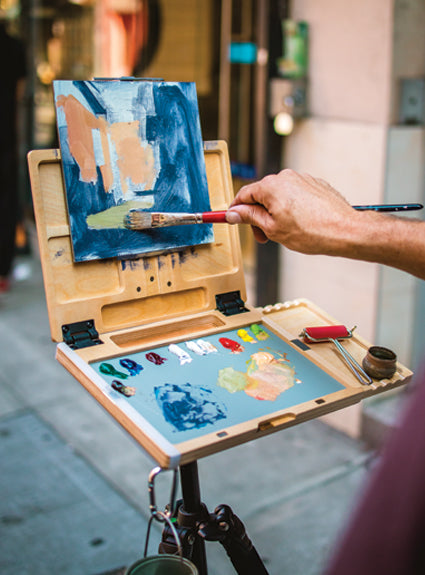INTERVIEW with KELLY FOSS
LOCATION
New York, New York
CAREER
Professional Artist, Author and Fine Art Instructor.
EDUCATION
Graduated Grand Central Atelier, Instructed by Scott Waddell and Tony Curanaj
WHAT IS A LITTLE KNOWN FACT YOU WOULD LIKE TO SHARE ABOUT YOURSELF?
I was drawing before I could speak and... I can lick my elbow!
YOU SPENT SOME TIME PLEIN AIR PAINTING ATOP A MOUNTAIN IN THE ADIRONDACKS THIS PAST SUMMER. TELL US ABOUT THAT!
It was breathtaking! The strong winds and cold provided a challenge but for those views, it was well worth it. Within moments the colors, clouds, and shadows drastically (and continually) changed. I would recommend painting on the top of a mountain to sharpen any artist’s plein air skills. It teaches decisiveness in composition and strengthens memory since the scene is changing before your eyes. Plus, it’s simply wonderful to get out in nature!
HOW DO YOU CHOOSE YOUR SUBJECT MATTER WHEN PLEIN AIR PAINTING?
There are a lot of factors that go into why I paint what I paint outdoors, like: how much time do I have, the size of my canvas, size of my brushes, lighting and shadows, and ultimately, what speaks to me. Sometimes I feel like painting a grand view and sometimes I feel like painting a near, tangible subject. But if there’s water around, you can pretty much guarantee I’ll be painting that.

DOES PLEIN AIR HELP SHARPEN YOUR OVERALL SKILLS AS A PAINTER?
Painting outdoors sharpens an artist’s ability to adapt to change while holding on to an aesthetic vision. Whenever I’m teaching a portrait or figure class or workshop I tell my students to embrace the micro-moves the model makes. People can get frustrated as a model naturally settles into a pose. Muscles relax, expression shifts, even the inhale and exhale can change the posture and appearance of a pose; but all those little adjustments add life to a drawing or painting. It adds breath to the canvas. Why does a short video of someone capture a person’s “totality” better than a still photograph? It’s because our eyes are picking up on the split seconds flashes of the best of their likeness. A photo might capture their smile, but not in that same moment a sparkle in their eye as they thought of something funny, or a tilt of their brow, or their chin being relaxed, etc.
The benefit of having a model in front of you for hours is you can capture on your canvas a spectrum of moments with your subject, eventually telling a better (fuller) story of that specific person rather than a specific moment of them. Working outdoors presents the same challenge of a “moving model” but in hyper drive! The trees are dancing, the clouds build and dissipate, and the sun speeds on its steady course. I choose a spot, get set up, and then look around to let it sink in. Then there’s nothing left to do but to jump in, and speed towards my vision. I do allow the changing scene around me to influence my painting’s development. It’s collaboration at this point, me and my surroundings in a race against time. My paintings won’t be a still moment, but many beautiful moments stitched together, moving. After working outdoors, going back to a model in studio will feel like an extremely controlled environment.

DO YOU HAVE ANY TECHNICAL ADVICE TO SHARE WITH THOSE WHO WANT TO PAINT OUTDOORS?
Starting with a white canvas out in the sunlight can not only be intimidating but also blinding! Consider toning your canvas to a nice tan color before heading out, or on location. Simply put a pearl size amount of raw umber oil paint on your canvas and rub it in using a paper towel you dipped into your odorless mineral spirits. If you’re doing it on location, to improve the setting speed you consider using a fast drying alkyd oil color.

WHAT ARE YOUR "GO TO" ART SUPPLIES?
When Plein Air Painting I keep in minimal. With no sink around to wash-up, I like to stay neat and clean while painting outdoors. I usually take with me a good amount of paper towels, a couple zip-lock bags (one to put my dirty paper towels in and the other to put my dirty brushes in), a leak-proof turp container is a must have, and recently I’ve simplified my colors to a white, yellow, red, blue, and a van dyke brown.
A recent edition to my setup has been a u.go Plein Air pochade box. I love it! Ever since getting mine I can’t go painting without one! I once tired leaving the house with my old box but it was just so heavy and bulky in my bag, I had to turn around and repack my bag.
When I'm back in the studio... Filbert brushes! They’re pretty much all I use nowadays. I always have a tube of Gamblin Solvent Free Gel on hand; a medium for those of us who don’t like using mediums. Can a hot drink in a thermos count as an art supply? If it’s morning it’s coffee, if it’s past noon it’s tea. Another must-have: upbeat music or music that goes with the theme of what I’m working on. Unless my brain isn’t staying focused, then I’ll listen to a TV series like The Office.

DO YOU HAVE ANY UPCOMING SHOWS, DEMONSTRATIONS OR CLASSES?
Right now I have plein air paintings in Philadelphia at Era Contemporary, show ending Dec. 7. In Texas, in 2019, I’ll have artwork at The Hal Marcus Gallery. Often people contact me directly to purchase or commission artwork, which I love! I instruct drawing workshops and teach classes with Drawing New York in Manhattan. People can email me (kellyfossart@gmail.com) to get on my list to receive notice of my shows, classes, and workshops.

-Kelly Foss
kellyfossart@gmail.com
instagram.com/kellyfossart
facebook.com/kellyfossart
www.kellyfoss.com










